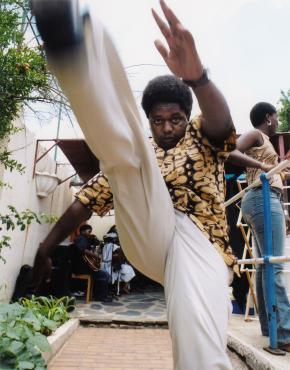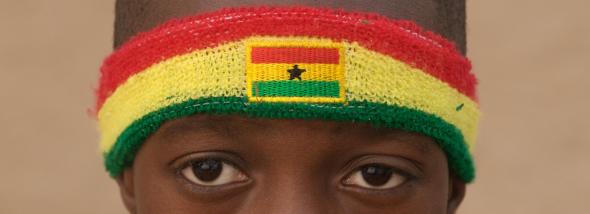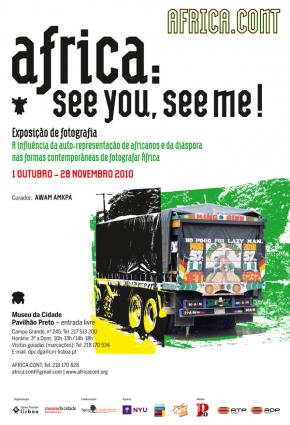AFRICA: see you, see me!
A Photographic exhibition curated by Awam Amkpa
(Associate Curator: Madala Hilaire)
 foto de Hank Willis ThomasWooden framed vehicles known as Mammy Wagons fly through potholes and blind corners into uncertain landscapes across West Africa, at speeds well above the 56 k.m.h. (kilometers per hour) emblazoned on their tails. They derive their name from market women who transport food crops like yams, tomatoes, onions, plantains, and palm oil across their home countries and into other nations.
foto de Hank Willis ThomasWooden framed vehicles known as Mammy Wagons fly through potholes and blind corners into uncertain landscapes across West Africa, at speeds well above the 56 k.m.h. (kilometers per hour) emblazoned on their tails. They derive their name from market women who transport food crops like yams, tomatoes, onions, plantains, and palm oil across their home countries and into other nations.
Besides discharging the important function of ferrying much needed food across nations,
these Mammy Wagons serve as billboards for artistic sign writing and paintings. These paintings might feature popular films, national symbols, or interpretations of African folktales. Captions or even gnomic statements written in English or French accompany the images. Statements such as “The Lord is My Sheppard”, “No Destination, Why Hurry”, “Justice
is the Poor man’s Wealth”, “The World is not for you alone”, are typical. Indeed, as the Mammy Wagons speed across poorly maintained roads and careen around uncertain corners, their billboards offer readers and onlookers a canvas of desires, frustrations, and hopes for a better society.
Africa: See You, See Me! takes its name from the artwork on a Mammy Wagon that I saw on a Nigerian road many years ago. The truck overtook the car in which I was riding, spurting a dark smelly smoke from its diesel fuel, and leaving us with the lasting image of two eyes framed by a paint-streaked map of Africa. Within the etching of Africa’s map, nestled the
inscription “See You, See Me!” As it crossed us, it inspired the occupants of my more sedate vehicle to wonder how we, as Africans, see and imagine ourselves, as well as how we want others to see us.
In this context, this exhibition uses photographic practices in Africa to draw attention to the ways in which Africans represent themselves, and the growing influence of these selfrepresentations in shaping general contemporary modes of photographing Africa.
African photographers inherited templates for photographic representations framed by colonial archetypes of Africans as objects of a history in which they were present, but over which they had no control. This paradigm of objectification promoted a weird presence/absence formula. It began to change, however, as Africans began to pose for their
own photographs they seemed to say, “the camera must see me as I want to be seen”.
Africa: See You, See Me! portrays the history of African photography and its influence on non-African imaginings of Africa and the African diaspora in all their diversity. Together, the photographs are texts of African subjectivities, archives of history and societies in the making, and methods for understanding how images contribute to emancipation. They
critique the pathologies of postcolonial and neocolonial Africa by depicting the continent’s communities disentangling themselves from repressive nation states. While some of the photographs document the participation of Africans in state affairs, others portray the formation of post-national voluntary communities as tools of empowerment.
Africa: See You, See Me is organized in 3 parts. The first section features studio portraits of Africans seeking to write themselves into the urban landscapes to which they have migrated.
It presents African photographers as they tamed, adapted and subverted the framing devices and photographic conventions bequeathed them by their former colonial masters. The black and white photographs by Mamadou Mbaye and Malick Sidibe illustrate a tense dialogue between the photographer and the photographed as they collaborate in inscribing African spaces and “selves” into photographic texts. Other themes in this section include the structures of African cities, societies and communities in formation, and representations of “looks” outside the studio from photographers in every region of the continent. This part of the exhibition also includes photographs of some of Africa’s anti-colonial heroes who hoped for genuine liberation.
The second section showcases early ethnographic portraits that imagined Africa as a wilderness peopled by Europe’s primitive “Other”. We have also used the strategy of rereading these photographs to draw attention to them as objects within the history of photography. That history was itself a significant product of an industrialized world that defined not only progress, but also constructed those at the center and peripheries of such progress in certain ways.
 foto de Stanley Lumax
foto de Stanley Lumax
The final section highlights contemporary photographs of Africa and Africans by non-African photographers who share a dialogic relationship with African artists. Thus, their work has expanded both African spheres of influence and multiplied the spaces in which Africans are photographed as subjects of history.
Like the Mammy Wagon I once saw on Nigerian roads, these photographs join works presented in the other sections, to tell Africans and the rest of the world: See You, See Me.
AFRICA.CONT
MUSEU DA CIDADE (Pavilhão Preto), LISBON 1st october to 28th of november. open at 30th September 19h
